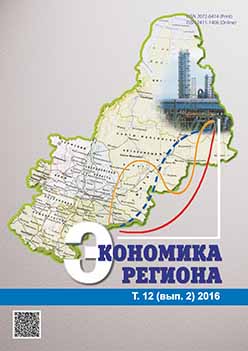Testing Kuznets’ Hypothesis for Russian Regions: Trends and Interpretations
Testing Kuznets’ Hypothesis for Russian Regions: Trends and Interpretations
Author(s): James R. Alm, Ruslan Arkadievich Grigoryev, Marat Vladimirovich Kramin, Timur Vladimirovich KraminSubject(s): Economy, Geography, Regional studies
Published by: Институт экономики Уральского отделения Российской академии наук
Keywords: inequality of income distribution; economic growth; Gini coefficient; competitiveness of regions; regression modeling; gross regional product; income; post-crisis period;regional policy;
Summary/Abstract: The paper established a number of "stylized facts", one of which is a confirmation of the S. Kuznets’ hypothesisof the nonlinear dependence between the degree of inequality in income distribution and welfareeconomic systems on the example of a group of Russian regions for the period 2002–2012. It is shown that,for a given sample, the welfare and economic growth factors amplify their influence on inequality in incomedistribution in the post-crisis period. The monotonous growth of income inequality which was observed beforethe crisis of 2008 is slowing in the process of raising the per capita gross regional product (GRP) duringthe post-crisis period, and for the foreseeable future, in some regions, its direction can be reversed, whilemaintaining a trend of socio-economic development. Despite the persistence over time of a convex nature ofS. Kuznets’ curve for Russian regional data, its parameters changed during the reporting 2002–2012 period.The maximum point of the curve shifts to the left, its convexity increases. These facts indicate that the incomeinequality growth of the Russian regions’ as a result of growth of per capita GRP is slowing. For some regionsin the post-crisis period, the income inequality does not grow with the growth of per capita GRP, or it even reduces.This fact can be attributed to the implementation of the Russian federal socially oriented projects andprograms in recent years. The results can be used for the development of regional economic policy in order toregulate the level of income distribution inequality in the regions of Russia.
Journal: Экономика региона
- Issue Year: 12/2016
- Issue No: 2
- Page Range: 560-568
- Page Count: 9
- Language: English

